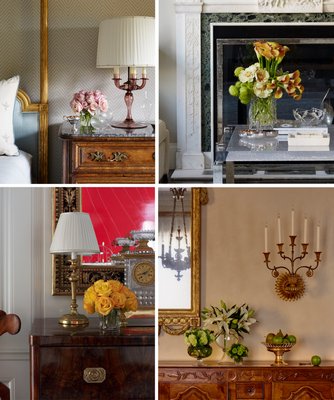
My gregarious friend, Brett, always placed a cheerful bowl of flowers on his cocktail table. In his clean, rather severe, modern apartment, sparingly decorated in tones of gray, silver and charcoal, the spray of blooms was a welcoming beacon, a sign of his warmth and hospitality. In those days, when none of us who were his friends could afford this kind of luxury, Brett, a gifted architect, insisted that he would rather eat a little less, and always have fresh flowers on the table. Even as his health deteriorated and his own finances were stretched thin, that vase of fresh flowers remained in place.
Finally, in a dark, austere chapel, on a cold autumn evening, his ashes were placed beneath a simple bowl of cheerful flowers whose blooms were lit by a single spotlight: a fitting tribute to a man whose life may have faded, but whose generous spirit never would.
Among many lessons, Brett taught me the powerful impact fresh cut flowers, greens and living plants have on elevating the interior—literally bringing life to the home. Of course, this is certainly not a lesson lost on shelter magazines, whose glossy pages are replete with gorgeous flora tumbling out of all manner of vessels.
The history of floral fashion just in the last 30 years since I began my career has seen tremendous change along with interiors, clothing, music and the economy.
During the opulent ’80s, no vase could be ornate enough, nor flowers dubbed as “arrangements” be more elaborate. Inspired by the Dutch masters’ paintings, giant heaps of flowers in every imaginable shape and color exploded from ornate stone carved urns or Meissen porcelain vases. FTD, I’m afraid, could not keep up with the demand and their stiff concoctions flooded American’s centerpieces.
After the “correction” in the market, a certain tucked-in minimalism hit the pages of the magazines with a single, white orchid arching over the lens, or a rather spent tulip lingering by the bedside.
This gave way to the “all-of-the-same-kind-of-bloom” bouquet, where glass cylinders sported a symmetrical mound of massed roses, whose tightly grouped buds had little room to unfold. It was all very structured.
Breaking out from this rigorously mathematical format, florists seemed to leap into the grocer’s aisles. Fruit and vegetables soon paired their edible qualities with loose branches of Kwanzan and quince. Artichokes, grapes, cabbage, citrus and all manner of beans proliferated the entry halls and living rooms of super-stylish apartments. You didn’t know whether to sniff the arrangement or eat it.
And lately, in the most fashionable magazine pages, branches of shapely leaves populate the rooms. The yellowed maple leaves of sango-kaku with striking red stems, or a swath of lime green ginkgo seem all the rage. Leafy ferns may be tucked by the bedside or maiden’s hair ferns gingerly peek out from a bathtub stand.
For me, simple bowls of flowers still suffice bringing life to our rooms and a reminder of my friend and mentor, Brett, who always said, “Life is just too short not to have a bowl of flowers.”